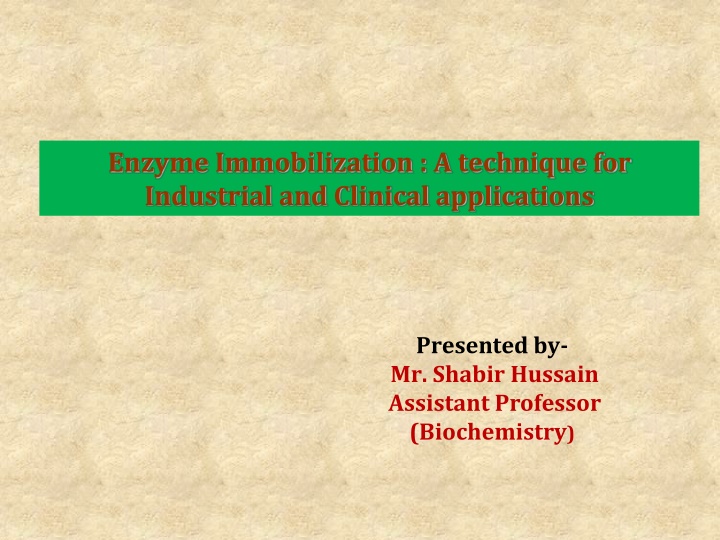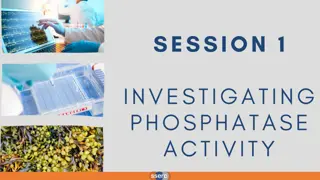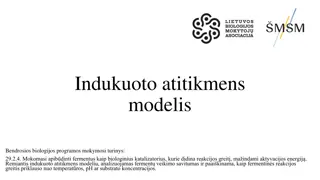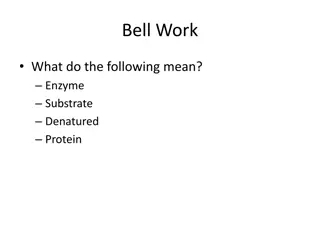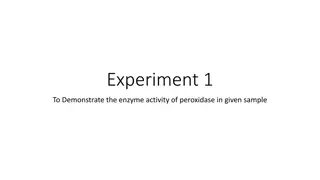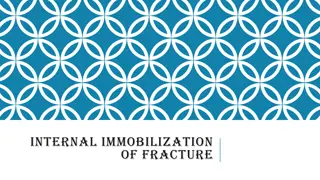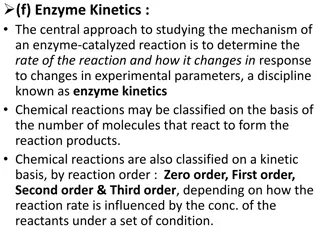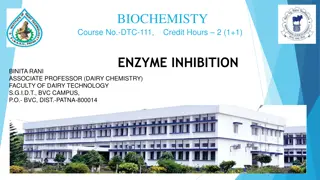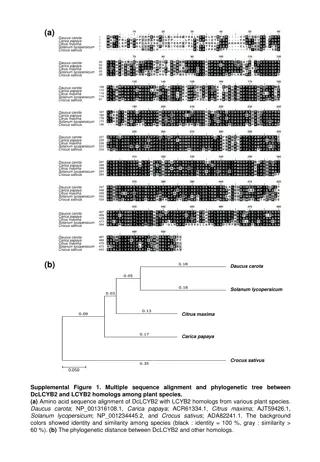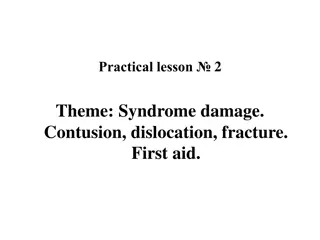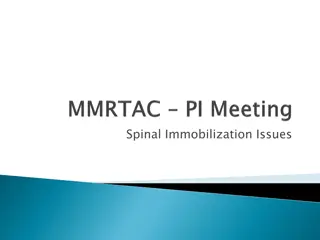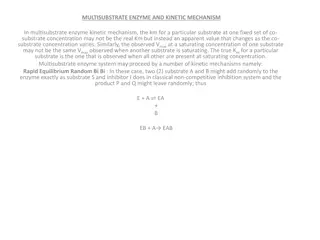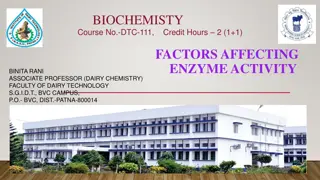Enzyme Immobilization: Techniques and Applications in Industry and Healthcare
Enzyme immobilization involves confining enzymes on inert supports for stability and reuse, enhancing efficiency and cost-effectiveness. Historical events and examples illustrate various methods and applications. Chemical modifications, such as PEG addition, have shown increased enzyme activity. The purpose includes reusing enzymes, lowering costs, and controlling reaction times. Materials like natural polymers and inorganic minerals are used for enzyme immobilization.
Download Presentation

Please find below an Image/Link to download the presentation.
The content on the website is provided AS IS for your information and personal use only. It may not be sold, licensed, or shared on other websites without obtaining consent from the author.If you encounter any issues during the download, it is possible that the publisher has removed the file from their server.
You are allowed to download the files provided on this website for personal or commercial use, subject to the condition that they are used lawfully. All files are the property of their respective owners.
The content on the website is provided AS IS for your information and personal use only. It may not be sold, licensed, or shared on other websites without obtaining consent from the author.
E N D
Presentation Transcript
Enzyme Immobilization : A technique for Industrial and Clinical applications Presented by- Mr. Shabir Hussain Assistant Professor (Biochemistry)
Introduction Immobilization of enzymes refers to the technique of confining / anchoring the enzymes in or on an inert support for their stability and functional reuse. By employing this technique, enzymes are made more efficient and cost effective for their industrial use. Immobilized enzymes retain their structural conformation necessary for catalysis.
Historical events Invertase immobilized on activated charcoal (Nelson & Griffin, 1916). Enzyme immobilization by covalent bonding on diazonium derivative(Grubhofer & Schleith,1953). Encapsulation of enzymes in semi-permeable spherical membranes(Chang, et al.,1964). Cross-linking of crystalline enzymes(Quiocho & Richards, 1964).
Aminoacylase immobilized on DEAE-sephadex used for production of L-aminoacid (Chibata, et al., 1967). Immobilized penicillin G acylase for production 6-APA (intermediate in synthesis of semi-synthetic antibiotics) (Mosbach, 1976). Immobilized glucose isomerase for production of fructose syrup (Messing & Filbert, 1975).
Obtained higher activity by chemical modification of enzymes(with PEG) (Takabaskal, 1984). Increase in optimum temperature of epoxy hydrolase (35-45o C) using Triton X-100 (Ursini et al., 1999). Development of cross-linked enzyme crystals (CLEC) suitable for both organic and aqueous media (Cao and Elzinga, 2003).
Purpose Re-use of enzymes for many reaction cycles. Ability of enzymes to provide pure products. Lowering the total production cost of enzyme mediated reactions. Minimize the enzymes lost in the product. Providing the ability to control reaction times. Easy separation from reaction mixture.
Material for Enzyme Immobilization Organic Natural polymers Polysaccharides: Cellulose , Agar, Agarose , Alginate Carbon: Activated charcoal Synthetic Polymers Polystyrene. Other polymers: polyacrylate, polyacrylamide, polyamides Inorganic Natural minerals: bentonite,Silica, Alumina Processed materials: glass
Properties of ideal carrier matrix Inertness toward enzymes. Physical strength (resistance to compression) Enhancement of enzyme specificity. Reduction in non-specific adsorption. Resistance to microbial attack. Reduction in product inhibition. Availability at low cost.
Methods for Enzyme Immobilization Physical adsorption Covalent bonding Entrapment Microencapsulation Microencapsulation Cross-linking
Physical adsorption Physical binding of enzymes on the surface of an inert support. Support materials may be inorganic (e.g. alumina, silica gel, calcium phosphate gel, glass) or organic (starch, carboxymethyl cellulose, DEAE-cellulose, DEAE - sephadex). Adsorption occurs by weak forces such as Van der Waals and hydrogen bonds. Adsorbed enzymes can be easily removed by minor changes in pH, ionic strength or temperature. Example Invertase was adsorbed on activated charcoal. (Nelson and Griffin, 1916)
Covalent bonding Immobilization by creation of covalent bonds between the chemical groups of the enzymes and the support. Technique is widely used, but is often associated with loss of some enzyme activity. The inert support usually requires pre-treatment (to form pre-activated support) before it binds to enzyme.
Cyanogen bromide activation Common methods of covalent bonding: Diazotation Peptide bond formation
Cyanogen bromide activation The inert support materials (cellulose, sepharose, sephadex) containing glycol groups are activated by CNBr, which then bind to enzymes and immobilize them. polysaccharide imidocarbonate derivative immobilized enzyme (Axen, et al., 1967)
Diazotation Some of the support materials (aminobenzyl cellulose, amino derivatives of polystyrene) are subjected to diazotation on treatment with NaNO2 and HCl. They in turn, bind covalently to tyrosyl or histidyl groups of enzymes. p- aminobenzyl cellulose diazonium derivative immobilized enzyme (Campbell, et al., 1951)
Peptide bond formation Enzyme immobilization can also be achieved by the formation of peptide bonds between the amino (or carboxyl) groups of the support and the carboxyl (or amino) groups of enzymes. CM- cellulose Carbodiimide Immobilized enzyme (Brandenberger, 1957)
Entrapment Entrapment inside a polymer or a gel matrix. Size of the matrix pores to retain enzyme (substrate and product molecules pass through). Enzymeis not subjected to strong binding forces and structural distortions. Deactivation may occur due to changes in pH or temperature or addition of solvents. Matrices include polyacrylamide gel, collagen gelatin, starch, cellulose, silicon.
Enzyme inclusion in gels Polyacrylamide gels: * ** acrylamide bis acrylamide polyacrylamid e *TEMED **Ammonium per Sulfate (Bernfeld and Wan, 1963)
Microencapsulation A spherical particle formation process where in a liquid or suspension is enclosed in a semi permeable membrane. The membrane may be polymeric, lipoidal, lipoprotein based or non ionic in nature. Example : Nylon microcapsules formed by hydrophillic monomer(1,6-hexamethylene diamine), hydrophobic monomer(sebacoyl chloride) and organic solvent cyclohexane-chloroform mixture. By formation of liposome. (Chang, et al., 1964)
Cross-linking Absence of solid support is a characteristic feature of immobilization of enzyme by cross-linking. Enzymes are immobilized by creating cross-links between them, through the involvement of polyfunctional reagents. Reagents reacts with the enzymes and create bridge which form the backbone to hold enzyme molecules. Reagents used for cross-linking include glutaraldehyde, diazobenzidine, hexamethylene and diisocyanate.
E.N CH CH E.N E.NH2 CHO (CH2)3 E.NH2 (CH2)3 CHO Glutaraldehyde Immobilized enzymes ENZYMES IMMOBILIZED BY CROSS-LINKING (Quiocho and Richards, 1964)
Advantages of Enzyme Immobilization Can be used repeatedly. Products are enzyme free. Easy to separate enzyme and products. Increase in thermo-stability of enzyme. Easy handling of enzymatic reaction. Allows catalysis in unfavourable media.
Disadvantages of Enzyme Immobilization Possibility of loss of biological activity of an enzyme. Immobilization means additional cost, require sophisticated equipments. Immobilization may alter shape of enzyme. Enzyme may become detached. Sometimes Immobilization adversely affect the activity of enzymes.
Applications in food industry. Clinical applications. Other applications.
Applications in food industry Synthesis of L-aminoacids by aminoacylase. Production of high fructose corn syrup(HFCS) by glucose isomerase. Production of lactose-free milk by -glactosidase. Production of glucose by -amylase. Clarification of fruit juices by Pectinases. Raffinase is used to remove raffinose in soyabean milk. Invert sugar is produced from sucrose by invertase. Urease used for removing urea from beverages and food products.
Synthesis of L-aminoacids by aminoacylase L- amino acids Acetyl D- amino acids Acetyl D-and L- amino acids (Chibata, et al., 1967)
Production of high fructose syrup by glucose isomerase (Messing and Filbert, 1975)
Clinical applications Detecting glucose concentration in blood by glucose oxidase and peroxidase. Removal of urea from blood during haemodialysis by urease. ELISA technique for HIV test and pregnancy test.
Detecting glucose concentration in blood by glucose oxidase and peroxidase: (Klang, et al., 1976)
Other Applications Production of semi-synthetic antibiotics like ampicillin by Penicillin G acylase. Catalase is used for determination of heavy metals(Hg) and pesticides on basis of enzyme inhibition principle. Glutathion S transferase is used to determine capton in water. Bacterial proteases used in leather industries.
Comparison of chemical and enzymatic process for hydrolysis of Pencillin G (Mosbach, 1976)
Future Prospects Although the best method of immobilization might differ from enzyme to enzyme, from application to application and from carrier to carrier, but the criteria for assessing the robustness of enzymes remain the same. So the focus should be the development of a new method that combines the advantages of carrier- bound and carrier-free methods which provide high enzyme loading, high retention of activity and broad reactor configurations.
Conclusion Immobilization technology will continue to create exciting new opportunities development / profits in a wide range of industrial sectors including healthcare and medicine, food technology, agriculture etc. Thus, immobilization technology offers a great deal of hope for solving many of the problems our world faces for commercial
